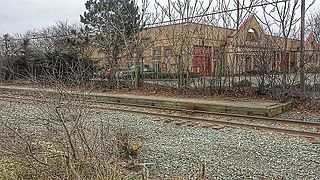
Attleboro is a city in Bristol County, Massachusetts, United States. It was once known as "The Jewelry Capital of the World" for its many jewelry manufacturers. According to the 2020 census, Attleboro had a population of 46,461.

North Attleborough, alternatively spelled North Attleboro, is a town in Bristol County, Massachusetts, United States. The population was 30,834 at the 2020 United States Census.
Washington Street is a street originating in downtown Boston, Massachusetts, which extends southwestward to the Massachusetts–Rhode Island state line. The majority of its length outside of the city was built as the Norfolk and Bristol Turnpike in the early 19th century. It is the longest street in Boston and remains one of the longest streets in the Commonwealth of Massachusetts. Due to various municipal annexations with the city of Boston, the name Washington Street now exists 6 or more times within the jurisdiction(s) of the City of Boston.

The Boston and Providence Railroad was a railroad company in the states of Massachusetts and Rhode Island which connected its namesake cities. It opened in two sections in 1834 and 1835 - one of the first rail lines in the United States - with a more direct route into Providence built in 1847. Branches were built to Dedham in 1834, Stoughton in 1845, and North Attleboro in 1871. It was acquired by the Old Colony Railroad in 1888, which in turn was leased by the New Haven Railroad in 1893. The line became the New Haven's primary mainline to Boston; it was realigned in Boston in 1899 during the construction of South Station, and in Pawtucket and Central Falls in 1916 for grade crossing elimination.

The Gorham Manufacturing Company was one of the largest American manufacturers of sterling and silverplate and a foundry for bronze sculpture.

The Napier Company is an American jewelry manufacturing company, and was one of the first modern corporations in the United States. The company is also known historically as a cutting-edge silver object manufacturer.

The North Attleborough Town Center Historic District encompasses the most historic elements of the central business district of North Attleborough, Massachusetts. The area was developed between about 1860 and 1830 as a center serving the community and the surrounding jewelry manufacturing businesses for which the town was well known. The district, extending along Washington Street between Fisher Street and Bruce Avenue, was added to the National Register of Historic Places in 1985.

Henry Northey Hooper was a preeminent 19th-century American manufacturer and merchant of decorative lighting, Civil War artillery, and bells and chimes. He was a Boston politician and foundry owner and in his firm he cast the first life-size bronze statue in the United States.

Balfour is an American producer of high school, college, military, and championship rings, as well as yearbooks, caps and gowns, and graduation announcements. Founded in 1913 as the L. G. Balfour Company, Balfour is an operating unit of Commemorative Brands, Inc., a subsidiary of American Achievement Corporation.

Taunton station was a passenger rail station located south of Oak Street in downtown Taunton, Massachusetts. As Taunton Central station, it served local and Boston-focused routes from 1836 to 1964. A later station at the same site served Amtrak's Cape Codder from 1986 to 1996, and Cape Cod and Hyannis Railroad commuter trains in 1988.

Black, Starr & Frost, previously known as Marquand and Co, is an American jewelry company. Founded in 1810 as Marquand and Co., the company is the oldest continuously operating jewelry firm in the United States. The company has acted as a retailer, rather than manufacturer, for most of its history.
R. Wallace & Sons was formed in Wallingford, Connecticut, and incorporated in 1879. As of 1893, this company manufactured silver and plated ware and cutlery and had about 600 employees.

The William B. Durgin Company was a noted American sterling silver manufacturer based in Concord, New Hampshire, and one of the largest flatware and hollowware manufacturers in the United States. Over the period 1905-1924 it was merged into the Gorham Manufacturing Company.

Lewis Edwin Jenks was a noted American silversmith, active in Boston.

Barton Pickering Jenks was a noted American silversmith, active in Boston.

Daniel Parker was an American silversmith, active in Boston.

J. Lewis Wyckoff, was an American businessman, stationery manufacturer, golfer, and promoter of golf. Wyckoff was the junior partner of the White & Wyckoff Manufacturing Company, a patron and backer of golf course architect Donald Ross, and a civic activist in Holyoke, Massachusetts who was largely responsible for its 1909 annexation of the village of Smith's Ferry from Northampton, Massachusetts. He was also referred to as the "father of Mount Tom Golf Club", which today bears his name as the Wyckoff Country Club, as well as its adjacent neighborhood, known as Wyckoff Park.
The Watson, Newell & Company Factory is a historic industrial complex at 67 Mechanic Street in Attleboro, Massachusetts. Built between 1889 and 1947, it is located on the site of the city's first textile mill, and was home to a prominent jewelry manufacturer for many years. It was listed on the National Register of Historic Places in 2020.
Edward Webb was a Colonial American silversmith, born in England but active in Boston. He apprenticed from 1680 until 1687 to William Denny, a London goldsmith, and may have been in Boston as early as 1704, but definitely by 1709. His work is collected in the Five Colleges Art Museums, Metropolitan Museum of Art, Museum of Fine Arts, Boston, and Yale University Art Gallery.

























